engine Abarth Grande Punto 2010 Owner handbook (in English)
[x] Cancel search | Manufacturer: ABARTH, Model Year: 2010, Model line: Grande Punto, Model: Abarth Grande Punto 2010Pages: 207, PDF Size: 3.01 MB
Page 151 of 207
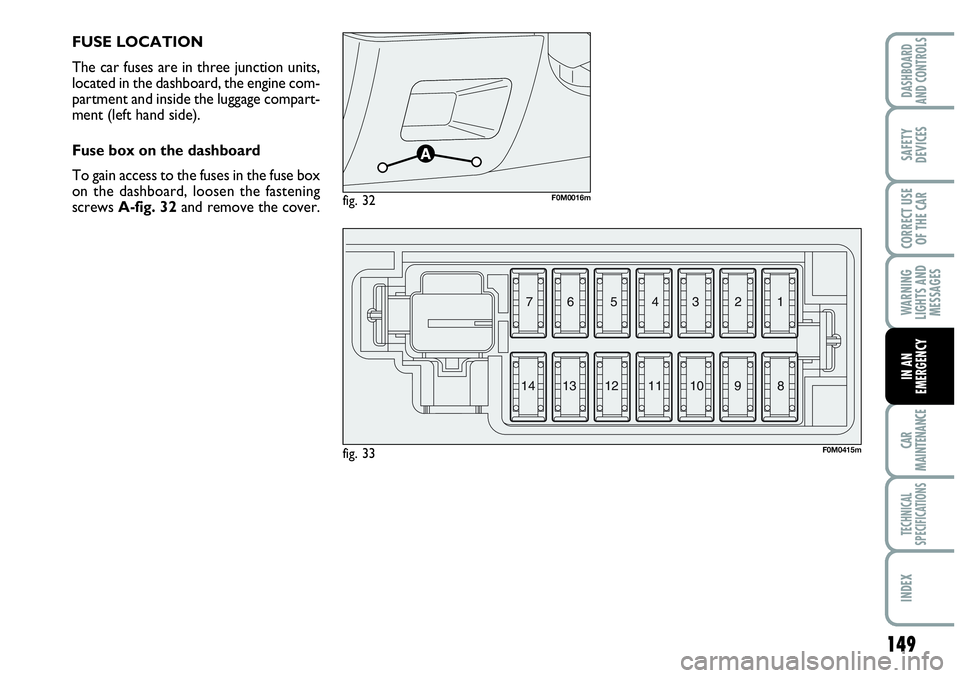
149
WARNING
LIGHTS AND
MESSAGES
CAR
MAINTENANCE
TECHNICAL
SPECIFICATIONS
INDEX
DASHBOARD
AND CONTROLS
SAFETY
DEVICES
CORRECT USE
OF THE CAR
IN AN
EMERGENCY
FUSE LOCATION
The car fuses are in three junction units,
located in the dashboard, the engine com-
partment and inside the luggage compart-
ment (left hand side).
Fuse box on the dashboard
To gain access to the fuses in the fuse box
on the dashboard, loosen the fastening
screws A-fig. 32and remove the cover.
fig. 32F0M0016m
fig. 33F0M0415m
3 4 5 6 7
8 9 10 11 12
13 141 2
Page 152 of 207
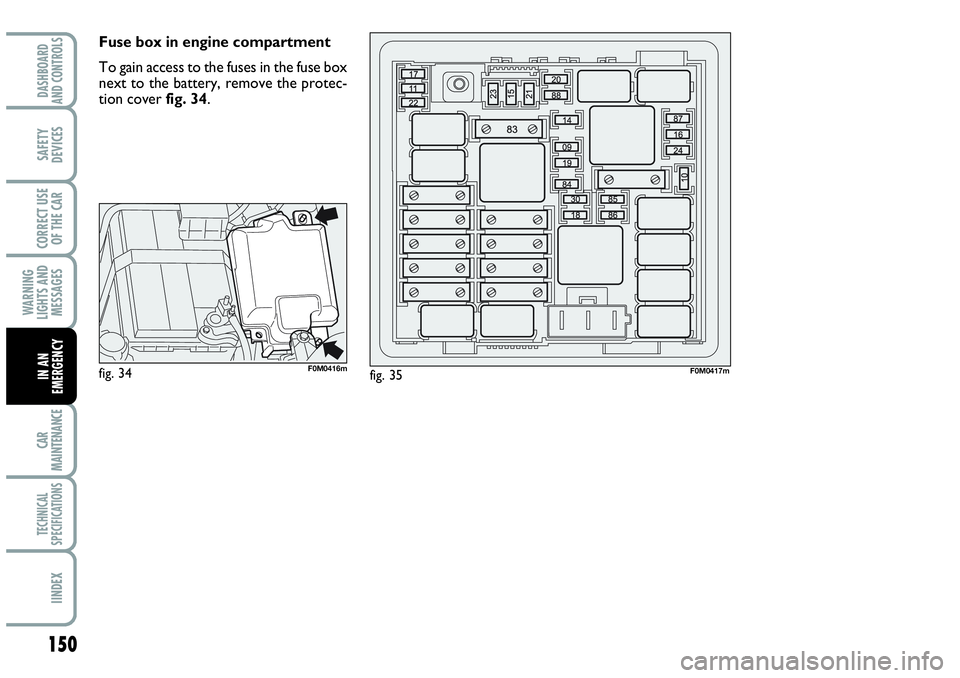
150
WARNING
LIGHTS AND
MESSAGES
CAR
MAINTENANCE
TECHNICAL
SPECIFICATIONS
IINDEX
DASHBOARD
AND CONTROLS
SAFETY
DEVICES
CORRECT USE
OF THE CAR
IN AN
EMERGENCY
Fuse box in engine compartment
To gain access to the fuses in the fuse box
next to the battery, remove the protec-
tion cover fig. 34.
fig. 34F0M0416mfig. 35F0M0417m
Page 154 of 207
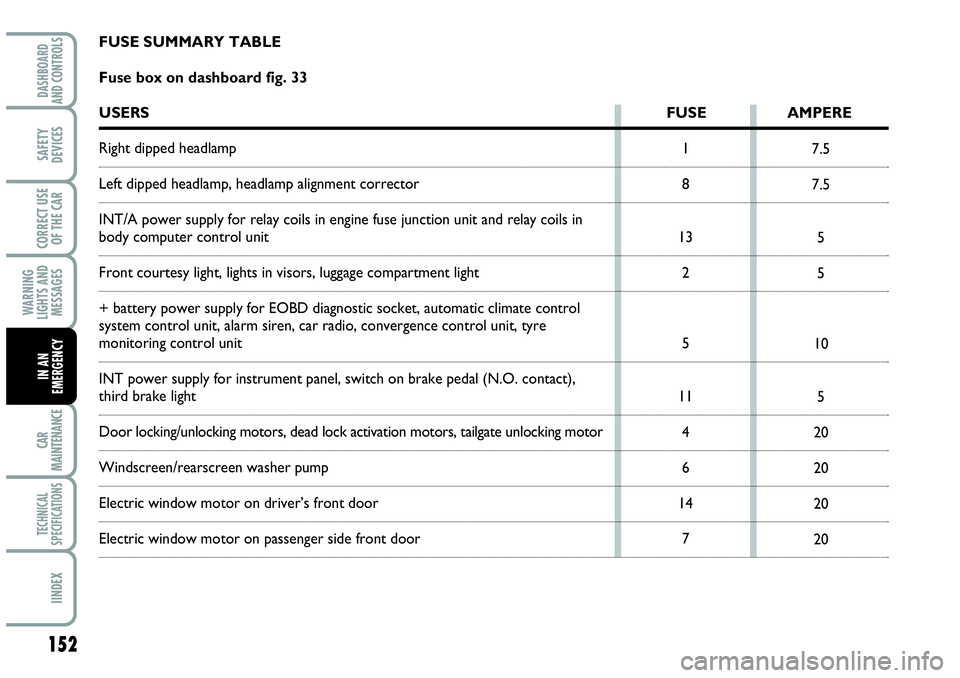
152
WARNING
LIGHTS AND
MESSAGES
CAR
MAINTENANCE
TECHNICAL
SPECIFICATIONS
IINDEX
DASHBOARD
AND CONTROLS
SAFETY
DEVICES
CORRECT USE
OF THE CAR
IN AN
EMERGENCY
7.5
7.5
5
5
10
5
20
20
20
20 1
8
13
2
5
11
4
6
14
7
FUSE SUMMARY TABLE
Fuse box on dashboard fig. 33
USERSFUSE AMPERE
Right dipped headlamp
Left dipped headlamp, headlamp alignment corrector
INT/A power supply for relay coils in engine fuse junction unit and relay coils in
body computer control unit
Front courtesy light, lights in visors, luggage compartment light
+ battery power supply for EOBD diagnostic socket, automatic climate control
system control unit, alarm siren, car radio, convergence control unit, tyre
monitoring control unit
INT power supply for instrument panel, switch on brake pedal (N.O. contact),
third brake light
Door locking/unlocking motors, dead lock activation motors, tailgate unlocking motor
Windscreen/rearscreen washer pump
Electric window motor on driver’s front door
Electric window motor on passenger side front door
Page 156 of 207
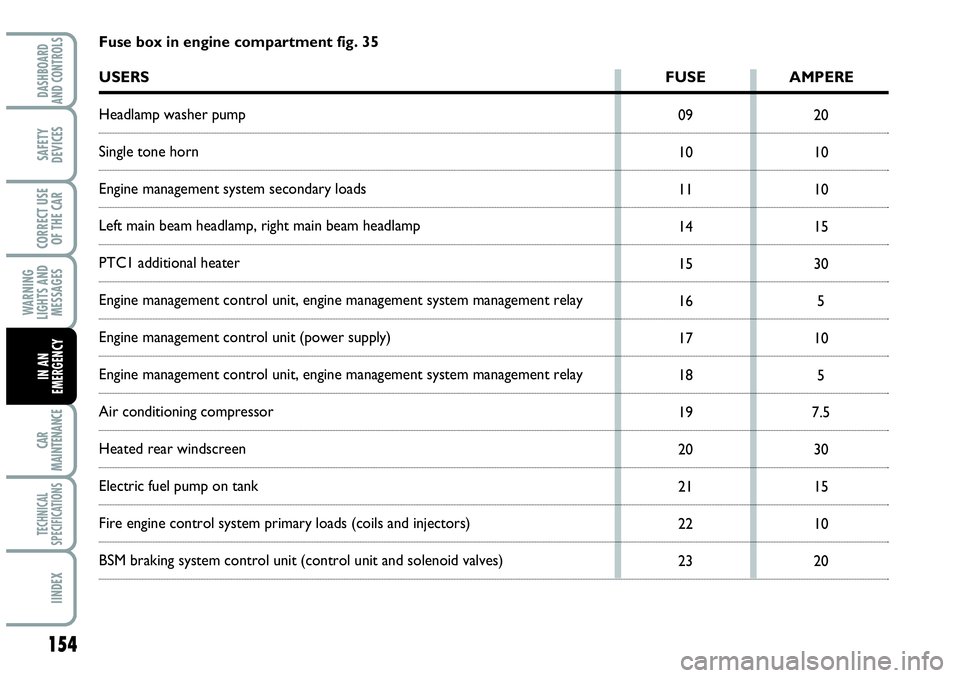
154
WARNING
LIGHTS AND
MESSAGES
CAR
MAINTENANCE
TECHNICAL
SPECIFICATIONS
IINDEX
DASHBOARD
AND CONTROLS
SAFETY
DEVICES
CORRECT USE
OF THE CAR
IN AN
EMERGENCY
Fuse box in engine compartment fig. 35
USERSFUSE AMPERE
Headlamp washer pump
Single tone horn
Engine management system secondary loads
Left main beam headlamp, right main beam headlamp
PTC1 additional heater
Engine management control unit, engine management system management relay
Engine management control unit (power supply)
Engine management control unit, engine management system management relay
Air conditioning compressor
Heated rear windscreen
Electric fuel pump on tank
Fire engine control system primary loads (coils and injectors)
BSM braking system control unit (control unit and solenoid valves)09
10
11
14
15
16
17
18
19
20
21
22
2320
10
10
15
30
5
10
5
7.5
30
15
10
20
Page 157 of 207

155
WARNING
LIGHTS AND
MESSAGES
CAR
MAINTENANCE
TECHNICAL
SPECIFICATIONS
INDEX
DASHBOARD
AND CONTROLS
SAFETY
DEVICES
CORRECT USE
OF THE CAR
IN AN
EMERGENCY
USERSFUSE AMPERE
ESP electric steering system control unit (+ignition power supply), NFR braking
system control unit (+ignition power supply), yaw sensor on tunnel
Left fog light, right fog light
Spare
Current socket (preparation)
Passenger compartment, cigar lighter current socket
Reversing light, relay coils on engine fuse junction unit
Defroster on driver’s door mirror, defroster on passenger side door mirror24
30
84
85
86
87
885
15
–
–
15
5
7.5
Page 162 of 207

160
WARNING
LIGHTS AND
MESSAGES
CAR
MAINTENANCE
TECHNICAL
SPECIFICATIONS
IINDEX
DASHBOARD
AND CONTROLS
SAFETY
DEVICES
CORRECT USE
OF THE CAR
IN AN
EMERGENCY
Do not start the engine
when towing the car.
WARNING
Before fitting the hook,
clean accurately its thread-
ed seat. Before starting to tow, make
sure to have tighten the hook.
WARNING
Before starting to tow, disen-
gage the steering lock (see
paragraph “Ignition device” in section
“Dashboard and controls”). When
towing, remember that without the
help of the brake booster and power
steering, a greater effort is required on
the pedal and steering wheel. Do not
use flexible cables for towing and
avoid jerks. During towing operations
make sure that fastening the joint to
the car does not damage the compo-
nents in contact with it. When towing
the car, you must comply with the spe-
cific traffic regulations regarding the
tow ring and how to tow on the road.
WARNING
Page 166 of 207
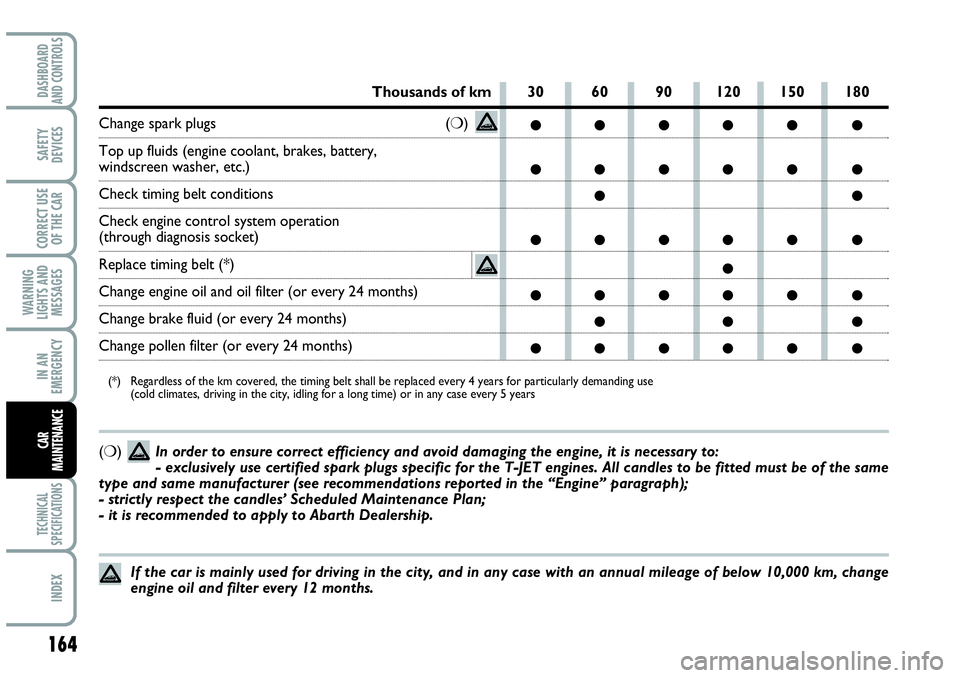
(❍) In order to ensure correct efficiency and avoid damaging the engine, it is necessary to:
- exclusively use certified spark plugs specific for the T-JET engines. All candles to be fitted must be of the same
type and same manufacturer (see recommendations reported in the “Engine” paragraph);
- strictly respect the candles’ Scheduled Maintenance Plan;
- it is recommended to apply to Abarth Dealership.
164
WARNING
LIGHTS AND
MESSAGES
TECHNICAL
SPECIFICATIONS
INDEX
DASHBOARD
AND CONTROLS
SAFETY
DEVICES
CORRECT USE
OF THE CAR
IN AN
EMERGENCY
CAR
MAINTENANCE
30 60 90 120 150 180
●●●●● ●
●●●●● ●
●●
●●●●● ●
●
●●●●● ●
●● ●
●●●●● ●
Thousands of km
Change spark plugs (❍)
Top up fluids (engine coolant, brakes, battery,
windscreen washer, etc.)
Check timing belt conditions
Check engine control system operation
(through diagnosis socket)
Replace timing belt (*)
Change engine oil and oil filter (or every 24 months)
Change brake fluid (or every 24 months)
Change pollen filter (or every 24 months)
(*) Regardless of the km covered, the timing belt shall be replaced every 4 years for particularly demanding use
(cold climates, driving in the city, idling for a long time) or in any case every 5 years
If the car is mainly used for driving in the city, and in any case with an annual mileage of below 10,000 km, change
engine oil and filter every 12 months.
Page 167 of 207
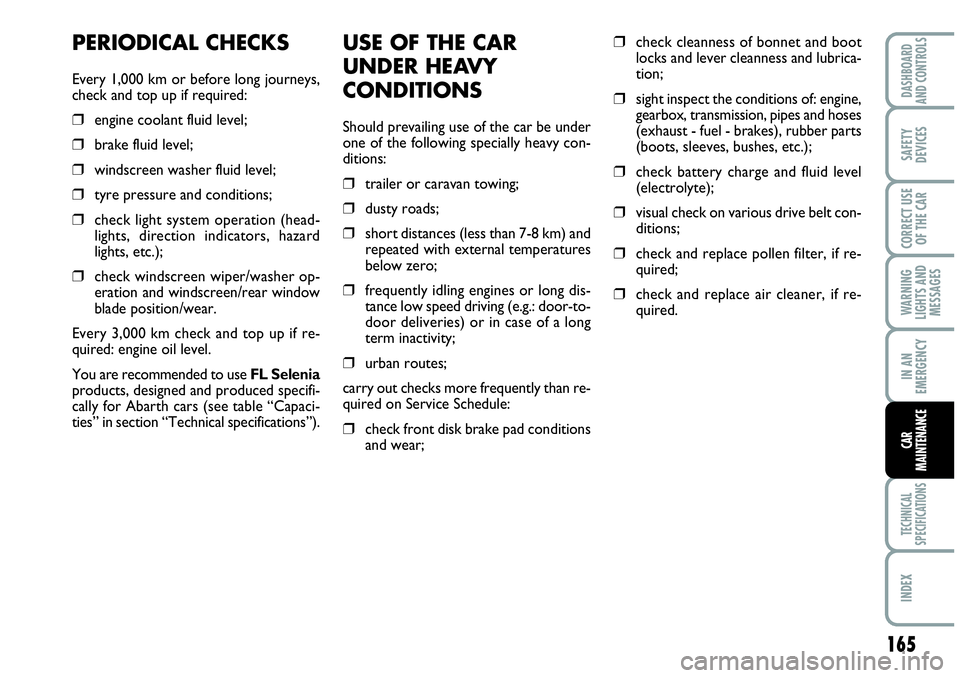
USE OF THE CAR
UNDER HEAVY
CONDITIONS
Should prevailing use of the car be under
one of the following specially heavy con-
ditions:
❒trailer or caravan towing;
❒dusty roads;
❒short distances (less than 7-8 km) and
repeated with external temperatures
below zero;
❒frequently idling engines or long dis-
tance low speed driving (e.g.: door-to-
door deliveries) or in case of a long
term inactivity;
❒urban routes;
carry out checks more frequently than re-
quired on Service Schedule:
❒check front disk brake pad conditions
and wear;
❒check cleanness of bonnet and boot
locks and lever cleanness and lubrica-
tion;
❒sight inspect the conditions of: engine,
gearbox, transmission, pipes and hoses
(exhaust - fuel - brakes), rubber parts
(boots, sleeves, bushes, etc.);
❒check battery charge and fluid level
(electrolyte);
❒visual check on various drive belt con-
ditions;
❒check and replace pollen filter, if re-
quired;
❒check and replace air cleaner, if re-
quired.
PERIODICAL CHECKS
Every 1,000 km or before long journeys,
check and top up if required:
❒engine coolant fluid level;
❒brake fluid level;
❒windscreen washer fluid level;
❒tyre pressure and conditions;
❒check light system operation (head-
lights, direction indicators, hazard
lights, etc.);
❒check windscreen wiper/washer op-
eration and windscreen/rear window
blade position/wear.
Every 3,000 km check and top up if re-
quired: engine oil level.
You are recommended to use FL Selenia
products, designed and produced specifi-
cally for Abarth cars (see table “Capaci-
ties” in section “Technical specifications”).
165
WARNING
LIGHTS AND
MESSAGES
TECHNICAL
SPECIFICATIONS
INDEX
DASHBOARD
AND CONTROLS
SAFETY
DEVICES
CORRECT USE
OF THE CAR
IN AN
EMERGENCY
CAR
MAINTENANCE
Page 168 of 207
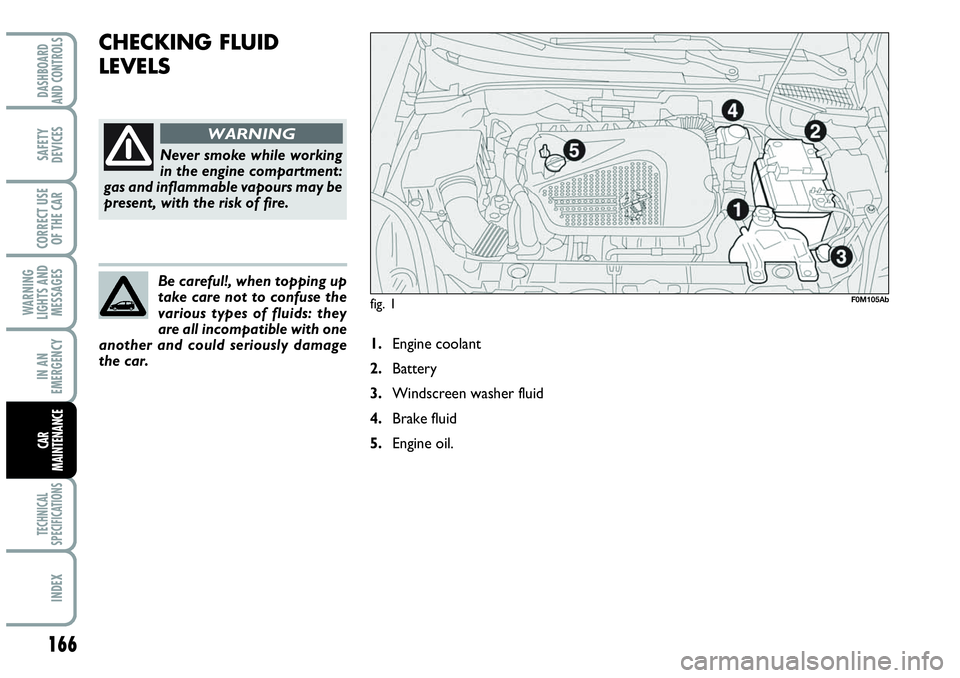
166
WARNING
LIGHTS AND
MESSAGES
TECHNICAL
SPECIFICATIONS
INDEX
DASHBOARD
AND CONTROLS
SAFETY
DEVICES
CORRECT USE
OF THE CAR
IN AN
EMERGENCY
CAR
MAINTENANCE
CHECKING FLUID
LEVELS
Never smoke while working
in the engine compartment:
gas and inflammable vapours may be
present, with the risk of fire.
WARNING
Be careful!, when topping up
take care not to confuse the
various types of fluids: they
are all incompatible with one
another and could seriously damage
the car.
fig. 1
1.Engine coolant
2.Battery
3.Windscreen washer fluid
4.Brake fluid
5.Engine oil.
F0M105Ab
Page 169 of 207
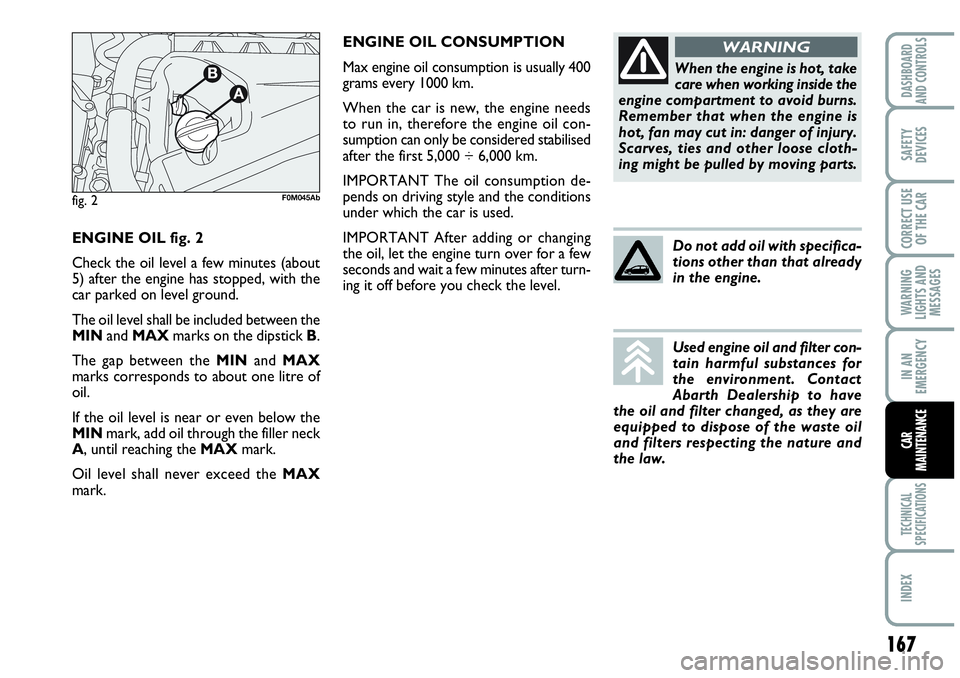
ENGINE OIL CONSUMPTION
Max engine oil consumption is usually 400
grams every 1000 km.
When the car is new, the engine needs
to run in, therefore the engine oil con-
sumption can only be considered stabilised
after the first 5,000 ÷ 6,000 km.
IMPORTANT The oil consumption de-
pends on driving style and the conditions
under which the car is used.
IMPORTANT After adding or changing
the oil, let the engine turn over for a few
seconds and wait a few minutes after turn-
ing it off before you check the level. ENGINE OIL fig. 2
Check the oil level a few minutes (about
5) after the engine has stopped, with the
car parked on level ground.
The oil level shall be included between the
MINand MAXmarks on the dipstick B.
The gap between the MINand MAX
marks corresponds to about one litre of
oil.
If the oil level is near or even below the
MINmark, add oil through the filler neck
A, until reaching the MAXmark.
Oil level shall never exceed the MAX
mark.
When the engine is hot, take
care when working inside the
engine compartment to avoid burns.
Remember that when the engine is
hot, fan may cut in: danger of injury.
Scarves, ties and other loose cloth-
ing might be pulled by moving parts.
WARNING
167
WARNING
LIGHTS AND
MESSAGES
TECHNICAL
SPECIFICATIONS
INDEX
DASHBOARD
AND CONTROLS
SAFETY
DEVICES
CORRECT USE
OF THE CAR
IN AN
EMERGENCY
CAR
MAINTENANCE
fig. 2F0M045Ab
Do not add oil with specifica-
tions other than that already
in the engine.
Used engine oil and filter con-
tain harmful substances for
the environment. Contact
Abarth Dealership to have
the oil and filter changed, as they are
equipped to dispose of the waste oil
and filters respecting the nature and
the law.